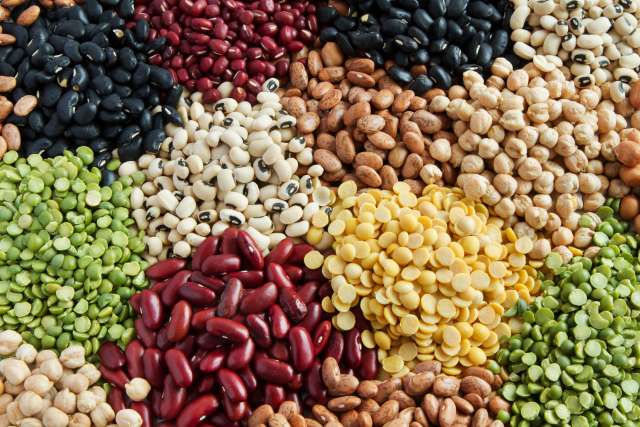Beans often get a bad rap, but occasional gas aside, they are among the healthiest foods you can eat.
“Beans are in a unique category because they are a protein source, but they are also complex carbohydrates,” says Mopelola Adeyemo, MD, a clinical nutritionist at UCLA Health. And, according to the U.S. Department of Agriculture (USDA) dietary guidelines, beans are classified as vegetables as well. Literally no other food can claim all that.
Nutrients in beans
When you’re looking for a food that’s nutrient dense (meaning it packs a lot of good stuff into not too many calories), beans should top your list. A serving of beans is just a half-cup. But that small amount is big on nutrients.
“One of the best things about beans is their very high fiber content,” says Dr. Adeyemo. A half-cup serving of black beans, for example, contains 8 grams of fiber. “That’s about 25% of the total fiber you need in a day in just that serving,” she says. That’s significant when you consider that only about 5% of Americans consume the recommended amount of fiber each day.
Beans are also a great source of plant-based protein. Whether you’re vegetarian or vegan — or just trying to reduce your consumption of meat — it’s important to find other good protein sources. A serving of beans averages about 8 grams of protein. A 3-ounce serving of beef, by comparison, has 22 grams of protein. “But even though they have less protein than animal sources, beans have much lower saturated fat or cholesterol,” says Dr. Adeyemo.
A serving of beans provides many other important nutrients as well. One half-cup contains between 300 and 500 milligrams of potassium (varies by type of bean). Potassium is an essential nutrient that plays a vital role in helping control blood pressure. Getting more of it can help balance out the negative blood pressure effects of consuming too much sodium. But most Americans don’t get enough potassium in their diets.
Beans are also rich sources of:
- Copper
- Folic acid
- Iron
- Magnesium
- Vitamin B6
Health benefits of beans
Many of beans’ biggest health benefits come from their high fiber content. “Beans, because of their fiber, can play a significant role in using food as medicine,” says Dr. Adeyemo. “Fiber decreases the amount of cholesterol absorbed when you eat.”
Bean benefits include:
- Lowers cholesterol: Replacing an animal protein with a serving of beans can help lower cholesterol levels.
- Lowers blood sugar: The combination of complex carbohydrates and fiber in beans helps keep blood sugar in check.
- Prevents constipation: Because fiber regulates your bowels, eating more beans can help keep you regular.
- Protects against colon cancer: Their effect on your digestive system may also be protective against colon cancer.
- Manages weight: The protein and fiber that beans contain can help you lose or maintain your weight. “The combination fills you up and keeps you feeling fuller longer,” says Dr. Adeyemo. “Studies have shown that people who regularly consume beans have lower body weight and smaller waist circumference than those who don’t.”
All these benefits can add up to a longer, healthier life. People who live in the so-called Blue Zones (areas of the world where the most people live to be 100 or older) typically eat about a cup of beans per day.
Why beans give you gas (and what to do about it)
All that good-for-you fiber is the main reason why beans cause bloating and gas. Fiber is harder for the body to digest, especially if you’re not used to eating enough of it. “Start with a small serving or spread your bean intake throughout the day,” suggests Dr. Adeyemo. “You don’t need to eat a whole serving in one meal or eat them every day as your body is getting more used to the added fiber.”
If you’re cooking with dry beans, experts recommend soaking them overnight before cooking. This can help draw out some of the gas-producing compounds. You can also add herbs that work as digestive aids while cooking your beans. Cumin, coriander, fennel and ginger are all good options.
Tasty ways to eat more beans
Beans are an incredibly versatile food. They’re also a very inexpensive form of protein. Using them in place of — or in addition to — some of the animal protein in your diet can be easy and delicious.
If you’re unsure how to incorporate beans into your meals, start small. Replace half the meat you would use with different types of beans when making dishes such as chili, tacos or burritos. You and your family might not even notice the difference.
As you get more comfortable cooking with beans, there’s no end to the creative ways you can use them:
- Puree white beans, black beans or chickpeas into a hummus or dip that you can scoop up with veggies or spread onto a sandwich.
- Use beans to make a veggie burger.
- Roast chickpeas until they’re crispy and eat them as a snack or in place of croutons on a salad.
- Mix beans into stews, soups and pasta sauces.
- Blend them with herbs to make pesto.
While there are many different types of beans, all are equally healthy. “The differences in fiber, protein and other nutrients are minimal,” says Dr. Adeyemo. “So pick the beans you enjoy the most.”

